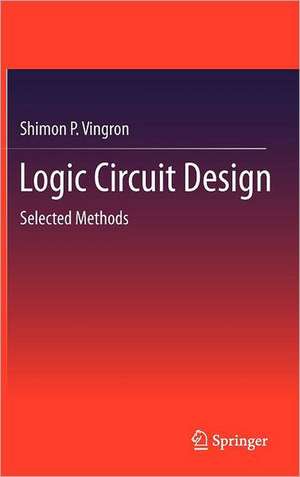Logic Circuit Design: Selected Methods
Autor Shimon P. Vingronen Limba Engleză Hardback – 30 mar 2012
The design of combinational circuits is discussed in an orthodox manner using normal forms and in an unorthodox manner using set-theoretical evaluation formulas relying heavily on Karnaugh maps. The latter approach allows for a new design technique called composition.
Latches are covered very extensively. Their memory functions are expressed mathematically in a time-independent manner allowing the use of (normal, non-temporal) Boolean logic in their calculation. The theory of latches is then used as the basis for calculating asynchronous circuits.
Asynchronous circuits are specified in a tree-representation, each internal node of the tree representing an internal latch of the circuit, the latches specified by the tree itself. The tree specification allows solutions of formidable problems such as algorithmic state assignment, finding equivalent states non-recursively, and verifying asynchronous circuits.
| Toate formatele și edițiile | Preț | Express |
|---|---|---|
| Hardback (2) | 645.47 lei 6-8 săpt. | |
| Springer International Publishing – 28 noi 2023 | 948.47 lei 3-5 săpt. | |
| Springer Berlin, Heidelberg – 30 mar 2012 | 645.47 lei 6-8 săpt. |
Preț: 645.47 lei
Preț vechi: 759.37 lei
-15% Nou
Puncte Express: 968
Preț estimativ în valută:
123.53€ • 127.61$ • 102.81£
123.53€ • 127.61$ • 102.81£
Carte tipărită la comandă
Livrare economică 25 martie-08 aprilie
Preluare comenzi: 021 569.72.76
Specificații
ISBN-13: 9783642276569
ISBN-10: 3642276563
Pagini: 250
Ilustrații: XIV, 258 p.
Dimensiuni: 155 x 235 x 23 mm
Greutate: 0.56 kg
Ediția:2012
Editura: Springer Berlin, Heidelberg
Colecția Springer
Locul publicării:Berlin, Heidelberg, Germany
ISBN-10: 3642276563
Pagini: 250
Ilustrații: XIV, 258 p.
Dimensiuni: 155 x 235 x 23 mm
Greutate: 0.56 kg
Ediția:2012
Editura: Springer Berlin, Heidelberg
Colecția Springer
Locul publicării:Berlin, Heidelberg, Germany
Public țintă
ResearchCuprins
Logic Variables, Logic Formulas, Karnaugh Maps, Reduced Karnaugh Maps.- Tautologies, Propositional Logic.- Canonical and Shegalkin Normal Forms, Minimising Logic Functions, Composition of Circuits.- Theory of Latches, Automata Models, Asynchronous Sequential Circuits, Verifying a Sequential Design.
Recenzii
From the reviews:
“In this book on logic circuit design (emphasis on ‘circuit’), the author reworks and expands the treatment provided in his earlier text, Switching theory: insight through predicate logic … . it will no doubt prove to be useful to engineers, circuit designers, etc., for its well-chosen examples and its ‘non-traditional’ emphasis on the underlying hardware realization problems of logic circuit design.” (Ronald E. Prather, Mathematical Reviews, January, 2013)
“In this book on logic circuit design (emphasis on ‘circuit’), the author reworks and expands the treatment provided in his earlier text, Switching theory: insight through predicate logic … . it will no doubt prove to be useful to engineers, circuit designers, etc., for its well-chosen examples and its ‘non-traditional’ emphasis on the underlying hardware realization problems of logic circuit design.” (Ronald E. Prather, Mathematical Reviews, January, 2013)
Textul de pe ultima copertă
In three main divisions the book covers combinational circuits, latches, and asynchronous sequential circuits. Combinational circuits have no memorising ability, while sequential circuits have such an ability to various degrees. Latches are the simplest sequential circuits, ones with the shortest memory. The presentation is decidedly non-standard.
The design of combinational circuits is discussed in an orthodox manner using normal forms and in an unorthodox manner using set-theoretical evaluation formulas relying heavily on Karnaugh maps. The latter approach allows for a new design technique called composition.
Latches are covered very extensively. Their memory functions are expressed mathematically in a time-independent manner allowing the use of (normal, non-temporal) Boolean logic in their calculation. The theory of latches is then used as the basis for calculating asynchronous circuits.
Asynchronous circuits are specified in a tree-representation, each internal node of the tree representing an internal latch of the circuit, the latches specified by the tree itself. The tree specification allows solutions of formidable problems such as algorithmic state assignment, finding equivalent states non-recursively, and verifying asynchronous circuits.
The design of combinational circuits is discussed in an orthodox manner using normal forms and in an unorthodox manner using set-theoretical evaluation formulas relying heavily on Karnaugh maps. The latter approach allows for a new design technique called composition.
Latches are covered very extensively. Their memory functions are expressed mathematically in a time-independent manner allowing the use of (normal, non-temporal) Boolean logic in their calculation. The theory of latches is then used as the basis for calculating asynchronous circuits.
Asynchronous circuits are specified in a tree-representation, each internal node of the tree representing an internal latch of the circuit, the latches specified by the tree itself. The tree specification allows solutions of formidable problems such as algorithmic state assignment, finding equivalent states non-recursively, and verifying asynchronous circuits.
Caracteristici
Presents fundamentally new methods for circuits Covers combinational circuits, latches and asynchronous sequential circuits Based on the successful monograph “Switching Theory” by the same author Includes supplementary material: sn.pub/extras
Notă biografică
Shimon Peter Vingron was born in Vienna, Austria, in 1936 and fled to England before the War with his family returning to Vienna in 1947. He studied mechanical engineering, physics and automation obtaining the degrees Ing., Dipl.-Ing., Dr. techn. and worked in industry in Germany and Austria. He lectured at the Ruhr University Bochum (Germany) and the Technische Universität Vienna,(Austria) and taught at the Engineering College Mödling, Austria. While at the Austrian Academy of Sciences he did research on sequential circuit theory. He has 2 patents, is the co-author of 2 books, and the author of 3.
